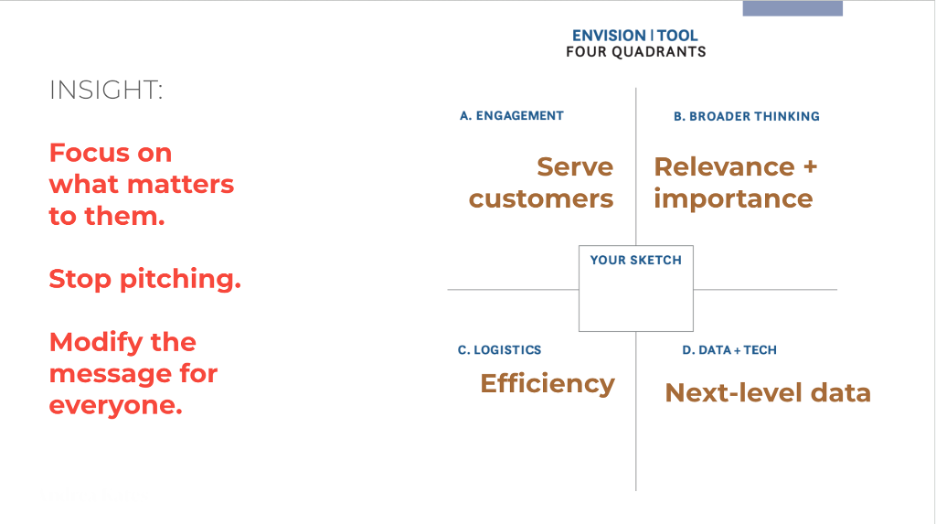
I remember standing in a room of five business owners who were leaders in the commercial building industry. They owned showrooms—physical locations where they sold carpets, interior finishes, office equipment, and fixtures. It was the early days of ecommerce and there were significant differences in approach and eagerness from leader to leader about how much to pay attention—or do something—in response to the ecommerce trend.
Thinking back to that scene, the common thread in their attitudes was: “People want to see and feel carpets. Our showrooms are safe from the e-commerce threat”
Of course, within a year, two of those companies had built online shopping businesses. Two added super innovative online tools for viewing rooms remotely, learning about the origin of their fibers, and integrating corporate office design services.
One went out of business and closed their showroom.
As we know, every business revolution sneaks onto the scene with lots of hoopla and is ignored by people who can’t be bothered, but embraced by a few. We experiment and change course trying to apply the new technology. Eventually, some people figured it out. But the people who never take action can’t catch up.
The AI wave we’re in the midst of right now reminds me of that ecommerce wave. Resistance is justifiably high fueled by fears, privacy concerns, and skepticism. The truth is, most of us want to act, but for some reason, we don’t. Every day we read the same statistics about teams that keep intending to do something about AI but don’t quite commit.

What does it take for people to get on board with AI adoption and apply it in the workplace?
Recently, I felt a deja vu of that e-commerce scene from years ago, only this time, switching the theme to AI. I was in Sâo Paulo, Brazil for an AI immersion co-sponsored by the MIT Legatum Center for Entrepreneurship and Development and Qintess, a tech transformation company. In a room of Qintess’ customers, the range of AI adoption was wide, and the first statistics that came up on screen seemed to foreshadow the future, with a gap between intentions and action that was hard to understand:
“The #1 strategic priority for senior leaders is AI/ML” [Gartner, A Journey Guide to Leading AI Success]
“7 percent of companies are bringing AI into their talent development.” [The Conference Board, a global network of corporate leaders.]
If I pictured that room of customers one year from now, I’d predict that 40% will have fully embraced AI in their companies, 40% will be slowly playing catch up, and 20% will be, well, too far behind to catch up with AI’s potential.
I’m committed to bridging the gap between what we want to do, or even need to do, and how we get ourselves and our teams to take action.
Here are insights from the experts on the state of AI today and its potential for driving economic impact. I’ve also translated what they said into action—what we can do differently to take full advantage of AI today to tackle the question: “How do we move from intention to action in applying AI at work?”
Some of the insights from our panel and other leaders:
Here’s How AI Adoption All Comes Together: How to get people on board.
I’ve been working with a leader who nailed the process of AI adoption. Her story provides a practical example of how you can take the first steps and get people on board.
Trish Barbato, CEO of Arthritis Society Canada is spearheading a nationwide initiative to accelerate the path to a cure for arthritis and significantly improve the lives of patients. One of the critical first steps in formulating a strategy was to conduct discussion groups with a wide range of people: patients, caregivers, scientists, healthcare administrators, and community members.
In the world of traditional research, the evaluation of the data from hundreds of hours of conversation would have taken weeks if not months. Thanks to automated transcription and analysis, the task of generating transcripts was easier than it would have been in the old days.
But analyzing all that information was still overwhelming.
Trish assigned a small team to apply AI to the evaluation process, making sure to use tools that would preserve the anonymity of the data (and not be on public servers.) The AI-generated spreadsheets with keywords and phrases in just a few hours. The team worked with that initial data sort and began a cycle of refinement, using prompts to not only evaluate what was said but also to suggest creative, actionable solutions.
She appealed to “4 quadrants” of motivation represented by different members of the team:
For the people who focused on the patient experience, she emphasized how much richer the consumer insights would be from the process
For the people who focused on broader thinking, she emphasized the ability to significantly expand their solution-brainstorming
For the people who focused on logistics, the time savings was a motivating factor that resonated
For the people who valued data, the initial results spoke for themselves: the data analysis was rich and the opportunities for refinement beyond the initial round provided next-level insights
What would have taken months took days, and the quality of ideas brought concepts that would not have been possible had they used traditional methods.
Download the deck to learn more about how you can adopt these strategies to aid in AI adoption for your organization.
Try this… |
|
What are you waiting for? Don't get left behind. Start your AI transformation now. Getting From Stuck to Scale is easier than you think.
Here to help,
















